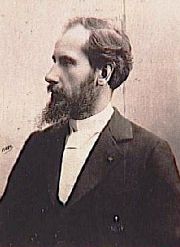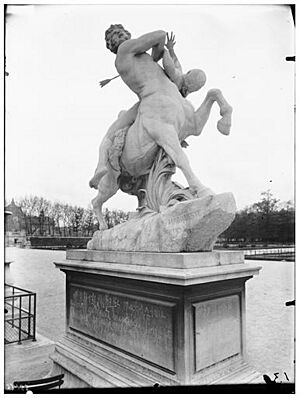Laurent Marqueste facts for kids
Quick facts for kids
Laurent Marqueste
|
|
|---|---|
 |
|
| Born |
Laurent-Honoré Marqueste
12 June 1848 |
| Died | 5 April 1920 (aged 71) |
| Nationality | French |
Laurent-Honoré Marqueste (born June 12, 1848, in Toulouse, France – died April 5, 1920, in Paris) was a famous French sculptor. He was known for his beautiful sculptures in the neo-Baroque style. This style was popular in the Beaux-Arts art movement.
He learned from well-known sculptors like François Jouffroy and Alexandre Falguière. In 1871, he won the important Prix de Rome award. This award helped him study art in Rome.
Contents
Early Life and Career Beginnings
Laurent-Honoré Marqueste was born in Toulouse, France, on June 12, 1848. He showed great talent for sculpture from a young age. His hard work led him to win the prestigious Prix de Rome. This award allowed him to train at the French Academy in Rome.
He first showed his art at the Paris Salon in 1874. His sculpture was called Jacob and the Angel. The Salon was a very important art exhibition in Paris.
Teaching and Recognition
Marqueste became a professor at the École des Beaux-Arts in 1893. This was a famous art school in Paris. He helped teach many new artists there.
In 1894, he became a member of the Institute. This was a high honor for artists in France. He also received the Legion of Honour award in 1884. He was later promoted to officer in 1894 and commander in 1903. These awards showed how much his country valued his art.
Marqueste's Sculptural Style
Marqueste was known for his amazing sculptures. Many of his works featured two figures together. These sculptures often looked very detailed and lifelike. He used skilled carvers to help create his large pieces. This was a common way for sculptors to work back then.
His art often included figures from history or mythology. He also created many sculptures for buildings. These were called allegorical architectural sculptures. They often represented ideas like art or geography.
Famous Works and Commissions
Marqueste created many important sculptures for public places. Some of his works can be found in famous buildings in Paris. These include the Musée d'Orsay (which used to be a train station), the Collège des Beaux-Arts, and the Grand Palais. The Grand Palais was built for the 1900 World's Fair.
He also made sculptures for the Sorbonne. One famous piece there is called Geography (1901). He sculpted portraits of important people too, like Victor Hugo and Léo Delibes. His sculptures can also be found in North and South America.
In 1900, he won the Grand Prix at the Paris World's Fair. This was a huge achievement for him.
Where to See His Art
You can find many of Marqueste's sculptures in museums. The Musée des Augustins in Toulouse has a large collection. It includes smaller statues and sketches called maquettes. This museum also has a portrait bust of Marqueste himself. It was sculpted by Ernest Henri Dubois.
Selected Works
- Velléda (a seated figure, 1877) - You can see this at the entrance to the Musée des Augustins, Toulouse.
- The Sorrow of Orpheus (1879)
- Diana Surprised at the Bath (1880)
- Cupid (Musée des Augustins, Toulouse)
- Galatea (1884)
- L'Art et la Fortune (Art and Fortune) (1887)
- Nessus and Deianira (1892) - This large sculpture is in the Tuileries Gardens in Paris.
- Perseus and the Gorgon (1890) - You can find this at the Musée des Beaux-Arts de Lyon and the Ny Carlsberg Glyptotek in Copenhagen.
- La Cigale (The Cicada) (1900)
- Hebe (1909) - This was shown at the Salon des artistes français.
See also
 In Spanish: Laurent Marqueste para niños
In Spanish: Laurent Marqueste para niños


